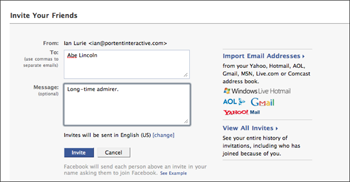Chapter 5: Building Your Network
In This Chapter
![]() Finding and keeping friends
Finding and keeping friends
![]() Expanding your network with questions and answers
Expanding your network with questions and answers
![]() Behaving yourself in social media
Behaving yourself in social media
To this point in this minibook, a lot of the mechanics of social media have been covered: setting up profiles, talking to your friends and followers, and posting new items. In this chapter, you see how to actually meet and keep friends — and how to deal with the occasional foot-in-mouth incident.
Finding Friends
All social media websites work on the principle of friends. In social media, a friend is someone who keeps tabs on what you’re doing on that particular site. The mechanism might vary, as you can see in Figure 5-1, but the principle remains the same: More friends means a bigger network, which means more people to pass your message along. That means more people to sell to, of course. But more importantly, it means that you have a larger audience of potential fans of you and your brand. They can tell other folks about you and multiply the number of people you can reach directly and indirectly.
Figure 5-1: Adding friends on Facebook.

• On social networks, such as Facebook, friends receive updates when their friends write a note, make a blog post, or take some other action. They can also send messages to each other.
• On bookmarking sites, such as StumbleUpon or Delicious, friends can share bookmarks and pass really interesting bookmarks to each other.
• On social news sites, such as Digg, friends can “shout” to each other about interesting stories.
• On microblogs, such as Twitter, friends (followers) see other friends’ posts.
• On media-sharing sites, such as YouTube and Flickr, friends can send each other videos.
Having a network of friends is how you really make social media marketing work. Friends are your “sneezers,” which you can also read about in Chapter 1 of this minibook: They pass along your message. Here’s how you find friends on any social media site:
• After you set up your profile, search for groups or content on the site that matches your interests or marketing goals. For example, you can look for Internet marketing groups or advertising and marketing posts. You’re interested in marketing your business, and these groups are a great resource.
• Invite the people who are participating in groups of interest to be your friends. On microblogs, follow the people you find interesting.
• Check your social media desktop. When stories, articles, or posts catch your eye, see whether the authors are members of the social media sites that you work on. If they are, invite them to be your friends or follow them.
• Get used to asking people you meet, “Are you on ___?” and then connecting with them online.
• Post early, post often. You’re probably tired of hearing “write interesting stuff,” but it’s true. When you post great photos, videos, and thoughts, you get friends and followers.
• Join groups. On sites that have groups, you should join.
• Latch on. You can find the biggest contributors on a given network and try to friend or follow them, too. But they will likely have thousands, if not tens of thousands, of messages and friends. You’ll have to get through the clutter.
Keeping Friends
After you get friends, how do you keep them? Some friends might stay with you because they’re simply too busy to remove you from their list. But you can take positive steps to keep friends around:
• Update. Remember your social media routine? Stick to it. Make a post, even if it’s just a sentence or two, or a link that you came across. Those contributions will show up in your friends’ updates, and these friends will remember who you are. And of course, they might pass the updates along, getting you even more friends.
• Reply. If friends send you something — a link, note, photo, or something else — reply to them. Make sure that they know you received it, and what you thought.
• Remember. If you’re on a social network, you likely have tools that report others’ birthdays and other special dates. A quick Happy Birthday note can go a long way to cementing a social media friendship.
• Curate. If you see something on another website or blog, or shared by someone in your network, and you think it’ll be useful to your followers, share it. This is content curation, and it’s one of social media’s most powerful uses. Do it right and you’ll gain a huge following — you’ll become a librarian and commentator for thousands of people.
• Behave. Read the rest of this chapter for more information about this, but you must respect others.
Expanding Your Network with Questions and Answers
You can attract a lot of followers and friends by asking the right questions. Sites and services (such as LinkedIn, Twitter, Plurk, and Yahoo! Answers) are particularly good places to try this strategy. A good question can be as interesting as a good answer. Just remember the sneeze principle; hop to Chapter 1 of this minibook if you haven’t read about this yet. You need to write the question in such a way that it encourages folks to pass it along.
Sniffle. “Does anyone know about Internet marketing?”
A-CHOO! “I own a bicycle shop and want to market it online. Anyone have advice or know someone who does?”
Suddenly you have a winner. This question is crafted well because it
• Is specific to an interest
Cyclists, other shop owners, and even other small business owners will pay attention.
• Invites others to respond
• Invites others to pass it along
By hitting these three points, you’re enhancing the community and attracting others at the same time. Win-win.
Of course, another great way to grow your network is to provide answers to some of those great questions. You have to accomplish two things if you’re going to answer questions and win friends:
• Find questions that need answering, even if the questioner isn’t your friend. Yahoo! Answers and LinkedIn do this for you. Other sites, such as Twitter and Facebook, aren’t as easy.
• Provide a really great answer. Also provide a way for the questioner to follow up if necessary.
Finding questions
Sites that aren’t specifically designed for question and answer don’t necessarily hide questions, but they can make them hard to find. Here are a few tips for finding questions:
• Facebook: Join groups and look in the discussions for each group. That’s where most will go looking for answers.
• Twitter: Use Twitter’s search service, search.twitter.com, to search for key terms. For example, searching for seo question can net you 10 to 20 good questions right away.
• YouTube: Search the comments on the site by using YouTube’s built-in search tool. Then answer questions with another comment.
Make great answers
Your answer should be very clear, offer steps to a solution, and/or invite the questioner to contact you directly if you can’t easily answer the question without more information or without more room for text. Twitter, for example, allows only 140 characters per post. Here’s a good example of an answer that has a good chance of gaining you a friend:
Hi John – I suggest starting out with a Kevlar-belted road tire first. They’re a little slower, but they’re nearly flat-proof. Try the Armadillo, or maybe the ReallyFlatProof106. If you have other questions, let me know: Bikerguy123
Obeying the (Unspoken) Rules
Here are a few unspoken social media rules:
Don’t Use Crass Promotion
If you find yourself writing something like “10% off sale on my site! Come now!” pinch yourself and delete your post. This kind of thing will only alienate your friends. It might even lead to penalties from the site owners.
Shameless plug: I just published a new book about Internet marketing. Please have a look at www.mybookwebsite.com.
The following is not acceptable, especially if you repeat it ten times per day:
Buy my new book! Learn how to earn millions online! www.mybook website.com.
Don’t Post Angry
No one can follow this rule 100 percent of the time. Eventually, someone will say something that really makes you angry, and you’ll retort and click Submit before you can stop yourself.
Wherever possible, avoid the angry post. If you’re inexorably drawn into an online shouting match, try these strategies:
• Take 5. Take 10. Take 100. Turn off the computer. Go outside. You’ll be surprised how minor the offending post or comment seems later.
• Go to the source. Contact the person via private or direct message. Instead of a slap fight, try asking, “Hey, did I just misunderstand?” or “What’d I do?”
• Vent in private. Get it out of your system by first writing any angry reply in a word processor. Then step back, take a breath, and edit it to be more diplomatic. Only then, post it.
Do Apologize
No matter what you do, at some point, you’re going to shove your foot firmly into your mouth. Social media is still social — you’re often talking to people all over the planet, and misunderstandings happen. If you offend, overreact, or just forget about a request someone made, just let him know that you’re sorry. Social media is all about online karma: The community will generally remember how you behave, but no one expects perfection. A little humility goes a long way.
Do Be a Good Citizen
Help others if they have questions about how to use the site or network. Lend a hand, just as others probably helped you when you signed up.
Do Add Value
Contribute to the community. If you’re microblogging, contribution can be as simple as an interesting link or video. On social networks, support the groups to which you belong by answering questions and inviting others to join. You don’t have to be the top expert in your field to add value. Value can mean humor, a sympathetic ear, or an interesting link, or just pointing a few people in the right direction.
Knowing When to Stop
Sometimes you can overstay your welcome. Here are a few sure signs that you should take a break and stop sending a specific person or group messages:
• The individual stops replying. Don’t take it personally, but do leave that person alone for a few days.
• A lot of friends or followers start unsubscribing or otherwise going away. Again, take a break. Look at what you’re writing. Any chance that a change is in order?
• You get a warning. This should be obvious: If a site moderator or other person in authority says, “Cool it!” you should listen.
• You feel like you’re working really hard to come up with something to say. Conversations can get strained and uncomfortable online, too. But you can walk away without offending anyone.
Social media communities are very tolerant. It’s unlikely that you’ll ever overstay your welcome. Just try to be somewhat self-aware, and take a break when you need it.


 Don’t become a question machine. Ask questions when you have them, rather than from some need to attract attention. Remember what it’s like when a little kid keeps asking, “Why?” every time you speak? That’s how other users feel when you start deluging them with questions.
Don’t become a question machine. Ask questions when you have them, rather than from some need to attract attention. Remember what it’s like when a little kid keeps asking, “Why?” every time you speak? That’s how other users feel when you start deluging them with questions.